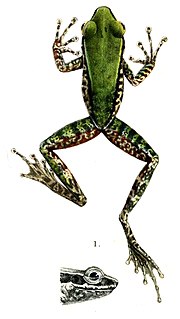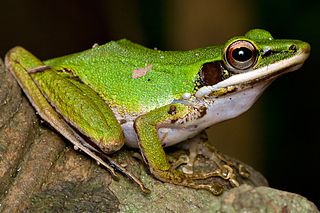
Hose's frog is a true frog species with a wide range in Southeast Asia. This species was named after zoologist Charles Hose.
Leptopelis crystallinoron is a species of frog in the family Arthroleptidae. It is endemic to Gabon and only known from the area its type locality near the Barrage de Tchimbélé in the central Monts de Cristal. Only one specimen was known until five specimens were captured in the Crystal Mountains National Park in 2009. It is probable that this species is endemic to the Monts de Cristal and that its range extends into Equatorial Guinea.
Leptopelis oryi, also known as the Garamba forest treefrog and Ory's tree frog, is a species of frog in the family Arthroleptidae. It is found in the northeastern Democratic Republic of the Congo, northwestern Uganda, and adjacent South Sudan. It is morphologically similar to Leptopelis nordequatorialis from Cameroon, and has also been considered its synonym, but is currently treated as a distinct species. The specific name oryi honours Albert Ory, warden in the Garamba National Park, the type locality of this species.
Leptopelis parvus, also known as the Kanole forest treefrog, is a species of frog in the family Arthroleptidae. It is endemic to the Democratic Republic of the Congo and is only known from the Upemba National Park.

Amolops spinapectoralis is a species of frog in the family Ranidae, the "true frogs". It is at present only known from a few locations in central Vietnam—that is, it is endemic to Vietnam—but it is likely to be found more widely in the Vietnamese Central Highlands as well as in the adjacent southeastern Laos and northeastern Cambodia. The specific name spinapectoralis is derived from Latin spina for "thorn" and pectoralis for "of the breast" and refers to the pectoral spines in adult males. Common name spinyback torrent frog has been coined for it.

The Amami tip-nosed frog is a species of frog in the family Ranidae. It is endemic to the Amami Islands, a part of the Ryukyu Islands, Japan. Specifically, it is known from the islands of Amamioshima and Tokunoshima.
Ingerana charlesdarwini is a species of frogs in the family Dicroglossidae. It is endemic to the Andaman Islands, India, and is known from the South Andaman Island, Long Island, and North Andaman Island.
Odorrana supranarina is a species of frog in the family Ranidae. It is endemic to Ryukyu Archipelago, Japan, and is known from the islands of Ishigaki and Iriomote, both in the Yaeyama Group. The specific name supranarina refers to the large size of this species —at the time of the species description, it was the largest member of the so-called Rana narina complex. Common name greater tip-nosed frog has been coined for it.
Odorrana utsunomiyaorum is a species of frog in the family Ranidae. It is endemic to Ryukyu Archipelago, Japan, and is known from the islands of Ishigaki and Iriomote, both in the Yaeyama Group. The specific name utsunomiyaorum honours Taeko and Yasuaki Utsunomiya for their contributions to clarifying the amphibian fauna of the Yaeyama Group.
Rhacophorus baliogaster, also known as the belly-spotted frog, is a species of frog in the family Rhacophoridae. It is found in the Central Highlands of Vietnam and the Annamite Mountains of adjacent Laos. Its range probably extends into eastern Cambodia where suitable habitat should be present. The specific name baliogaster is derived from the Greek words balios and gaster, meaning "spotted or dappled belly".
Chalcorana labialis, also known as the white-lipped frog, is a species of "true frog" in the family Ranidae. As currently known, it is endemic to Peninsular Malaysia, although it might also occur in Singapore. Molecular data suggest presence of three distinct lineages in the same area, one of which is not closely related to Chalcorana labialis and which could represent an unnamed species.
Chalcorana chalconota is a species of "true frog", family Ranidae. It is endemic to Indonesia and occurs in southern Sumatra, Java, Bali, and a few smaller islands. Populations previously assigned to this species now belong to a number of other Chalcorana species, leading to the current delineation of Chalcorana chalconota with a much narrower range. This species is also known as the Schlegel's frog, brown stream frog, copper-cheeked frog, or, among with many other species, white-lipped frog.

Chalcorana macrops is a species of "true frog" in the family Ranidae. It is endemic to Sulawesi, Indonesia. Common name Masarang frog has been coined for it. The specific name macrops refers to the large eyes of this frog.

Chalcorana megalonesa is a species of true frog in the family Ranidae, the "true frogs". It is endemic to Borneo and is known from both Malaysia and Indonesia (Kalimantan). It was split off from Rana chalconota in 2009 by Robert Inger and colleagues, along with a number of other species. Common name large white-lipped frog has been coined for it.
Chalcorana parvaccola is a species of "true frog" in the family Ranidae. It is endemic to Sumatra, Indonesia. It was split off from Chalcorana chalconota by Robert Inger and colleagues in 2009, along with a number of other species. The specific name parvaccola is derived from Latin parvus meaning small and accola meaning neighbor, and refers to this species being smaller than its "neighbor", the related Sumatran species Chalcorana rufipes.

Chalcorana raniceps, also known as the copper-cheeked frog, white-lipped frog, or Peters' Malaysian frog, is a species of "true frog" in the family Ranidae. It is endemic to Borneo, including Brunei Darussalam, Kalimantan (Indonesia), and Sarawak (Malaysia), although it is likely to occur more widely. Previously mixed with Chalcorana chalconota and believed to have much wider distribution, its range was delimited to Borneo in the revision of "Rana chalconota" complex by Robert Inger and colleagues in 2009.
Chalcorana rufipes is a species of "true frog" in the family Ranidae. It is endemic to Sumatra, Indonesia. It was split off from Chalcorana chalconota by Robert Inger and colleagues in 2009, along with a number of other species. The specific name rufipes is derived from Latin rufus meaning reddish and pes meaning foot, in reference to the reddish tinge on the underside of the pedal webbing in life.
Chalcorana scutigera is a species of "true frog" in the family Ranidae. However, it is a poorly known species that might actually be synonymous with Polypedates leucomystax. It is endemic to Peninsular Thailand. Common names Haut Sanuk frog and yellow trea frog have been coined for it.
Papurana supragrisea is a species of true frog, family Ranidae. It is endemic to New Guinea, including some nearby islands. It is known with certainty only from southeastern New Guinea and from the D'Entrecasteaux Islands. However, this name has been used more broadly for a species complex that is widely distributed in the mountains of New Guinea. Common name Papua gray frog has been coined for it.
Amolops akhaorum is a species of true frogs discovered in 2007 in the Nam Ha National Protected Area, north-western Laos. It is still only known from its type locality. The specific name akhaorum refers to the local Akha people who helped with the fieldwork of the team who discovered the species.






